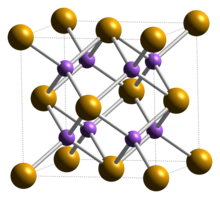Sodium selenide is an inorganic compound of sodium and selenium with the chemical formula Na2Se.

| |

| |
| Names | |
|---|---|
| IUPAC name
sodium selenide
| |
| Identifiers | |
3D model (JSmol)
|
|
| ChEBI | |
| ChemSpider | |
| ECHA InfoCard | 100.013.830 |
| EC Number |
|
PubChem CID
|
|
| UNII | |
CompTox Dashboard (EPA)
|
|
| |
| |
| Properties | |
| Na2Se | |
| Molar mass | 124.951 g·mol−1 |
| Density | 2.62 g cm−3[1] |
| Melting point | >875 °C[1] |
| reacts with water | |
| Structure[2] | |
| Cubic (fluorite), cF12 | |
| Fm3m, No. 225 | |
a = 0.6825 nm
| |
Formula units (Z)
|
4 |
| Hazards | |
| GHS labelling: | |
  
| |
| Danger | |
| H301, H331, H373, H410 | |
| P260, P261, P264, P270, P271, P273, P301+P310, P304+P340, P311, P314, P321, P330, P391, P403+P233, P405, P501 | |
| Related compounds | |
Other anions
|
Sodium oxide Sodium sulfide Sodium telluride Sodium polonide |
Other cations
|
Hydrogen selenide Lithium selenide Potassium selenide Rubidium selenide Caesium selenide |
Related compounds
|
Sodium selenite Sodium selenate Aluminum selenide Antimony selenide |
Except where otherwise noted, data are given for materials in their standard state (at 25 °C [77 °F], 100 kPa).
| |
Preparation
editThis colourless solid is prepared by the reaction of selenium with a solution of sodium in liquid ammonia at −40 °C.[3] Alternatively, sodium selenide can be prepared by the reaction of gaseous hydrogen selenide with metallic sodium at 100 °C.
Reactions
editLike other alkali metal chalcogenides, this material is highly sensitive to water, easily undergoing hydrolysis to give mixtures of sodium biselenide (NaSeH) and hydroxide. This hydrolysis occurs because of the extreme basicity of the Se2− ion.
- Na2Se + H2O → NaHSe + NaOH
Similarly, sodium selenide is readily oxidized to polyselenides, a conversion signaled by off-white samples.
Sodium selenide reacts with acids to produce toxic hydrogen selenide gas.
- Na2Se + 2 HCl → H2Se + 2 NaCl
The compound reacts with electrophiles to produce the selenium compounds. With alkyl halides, one obtains a variety of organoselenium compounds:
- Na2Se + 2 RBr → R2Se + 2 NaBr
Organotin and organosilicon halides react similarly to give the expected derivatives:
- Na2Se + 2 Me3XCl → (Me3X)2Se + 2 NaCl (X ∈ Si, Ge, Sn)
References
edit- ^ a b Haynes, William M., ed. (2016). CRC Handbook of Chemistry and Physics (97th ed.). CRC Press. p. 4.87. ISBN 9781498754293.
- ^ Bonneau, Philippe R.; Jarvis, Robert F.; Kaner, Richard B. (1992). "Solid-state metathesis as a quick route to transition-metal mixed dichalcogenides". Inorganic Chemistry. 31 (11): 2127–2132. doi:10.1021/ic00037a027.
- ^ Brauer, G. ed. (1963) Handbook of Preparative Inorganic Chemistry, 2nd Ed., Academic Press, NY., Vol. 1. p. 421.